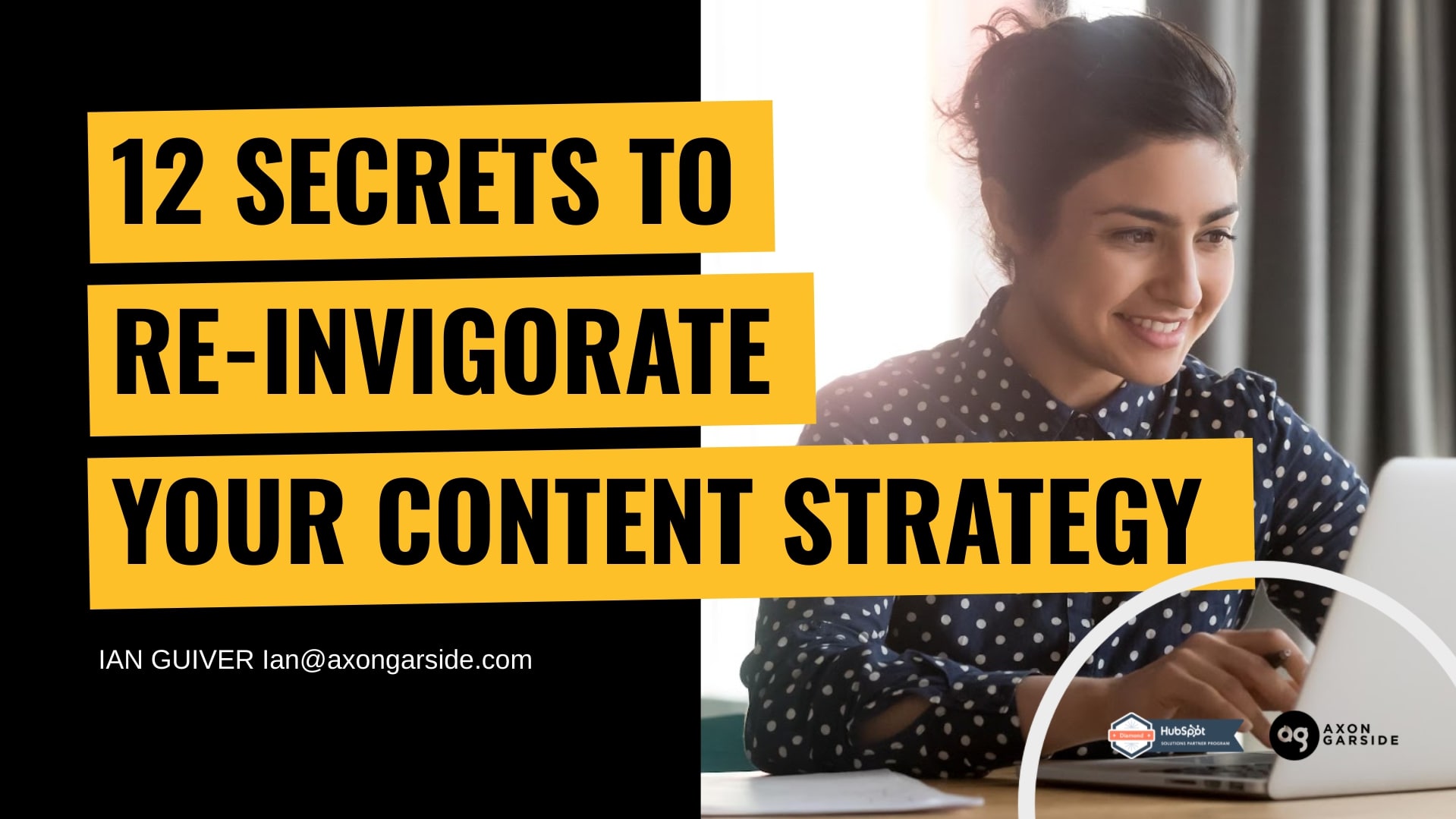Content Marketing: The Elephant in the Room
Is content marketing the elephant in the room? Our experts tackle this question and offer strategies to make it a key driver of your marketing success.

From the perspective of the buyer, it can be daunting to find good quality content in amongst the avalanche of seen-before stuff that rehearses tired perspectives and adds little value. 200,000,000 blogs are posted online every single day - you can’t afford to fall through the cracks with your content marketing strategy.
Nowadays, most B2B companies either publish online content (such as blogs, videos, and eBooks) or operate in markets where their competitors do, which is where the central challenge lies; how do you get your content found and engaged with? The answer lies in having an exceptional B2B content marketing strategy.
Although four in five B2B marketers say that they have a content plan in place, by their own admission, they don’t have the quality of content required to deliver a competitive advantage. In the B2B world, there is a lot of talk about adopting different platforms as a solution to the question of how we can stand out in the increasingly crowded content universe. Let’s take a closer look at what can actually make a difference for your content marketing strategy.
79% OF B2B ORGANISATIONS HAVE A CONTENT MARKETING STRATEGY, BUT ONLY 7% DEEM THEIR CONTENT TO BE ‘EXCEPTIONAL’
1. Buy-IN
Too many sales directors - and C-Suite executives for that matter - still don't recognise that the B2B buyer has gone online and that digital content marketing is a key part of the solution. Too many of us still hear "I haven't got time" when we ask for ideas and support from in-house subject experts.
"HAVEN'T GOT TIME" REALLY MEANS "I DON'T VALUE WHAT YOU ARE DOING".
This is nuts, of course, but it means that as marketers we need strategies to win hearts and minds. Many try to deal with the issue by skillfully navigating around sales and service teams to get their content strategy implemented. This is a flawed plan because content marketing is about deploying an organisation's expertise to attract potential buyers, differentiate from competitors, and engage potential leads.
This expertise, the experience that comes from working closely with customers, and understanding what the customer needs to know, is more often than not in the heads of the folk on the front-line: sales, pre-sales consultants, and service teams.
We have three strategies to overcome this challenge:
- WHAT is content marketing?
- HOW will we execute our strategy?
- WHY is it important?
We need to take time to explain, document, and remind colleagues WHAT we are doing, HOW we will execute, and WHY we are doing it in the first place. This is inevitably going to require us to demonstrate with facts that our buyers have gone online and evidence how the modern buyer consumes digital content throughout the buyer journey.
We can either be part of that conversation and have influence or, stand aside and leave the field to our competitors. This is best done through a workshop involving sales, service, and senior management. At Axon Garside, we insist that such a workshop takes place at the beginning of any new engagement with the full engagement of sales and other stakeholder teams. Without that step, we know that we will struggle to deliver ROI.
67% of the buying process now takes place online (SiriusDecisions, 2018)
An important part of making the case is the use of objective data. At Axon Garside, we are able to show data from our client base and from the wider HubSpot user base - but there is also a lot of publicly available data to make the case.
Every good salesperson knows that the best leads are those who have not yet defined exactly what they want to buy - because then the only thing they want to talk about is price. The earlier that your sales team gets the chance to speak to a potential buyer, the more they have the opportunity to influence buyer criteria - increasing the chances of closing the deal. Content marketing provides that opportunity by offering content that addresses the buyer information needs throughout the buyer journey of awareness, consideration, and decision.
The next step is to build a single content team that crosses departmental boundaries
This can start with something as simple as language: it is not marketing’s lead generation problem - or sales lead closure problem. It is ‘our’ problem.
We also need an advocate for content inside the sales and service organisation. Without that, there will be no one to champion the creation of content and no one to make sure that it is a priority. This, of course, is not a full-time role. Its existence ensures that we have a company-wide commitment to addressing sales and marketing challenges that cannot reside in one department if you are to effectively align sales and marketing and grow your business.
Marketers need to help sales to see the job of the content team as building up the profiles of our sales teams - and positioning them as experts. Because, as has often been said, people buy from people in B2B. We’ll share the work, but we need sales to give their time and experience to help us to do that job.
2. SINGLE PROCESS: OUR PROBLEM
HubSpot combines sales and marketing
Now, we’ve discussed how data needs to help make the ‘case for content’. Marketers must be able to show how the consumption of individual pieces of content has played a key role in the lead generation process.
To do this, marketers need software that can measure interactions, website visits, and conversion rates throughout the marketing and sales funnel. Not only this, but software that also illustrates how the different elements of a content strategy are dependent on each other. Without such a tool, it will be hard to measure the effectiveness of individual content pieces so that colleagues can understand the value of the work that they have helped to create. HubSpot is our solution of choice but other tools are available to you.

Bearing in mind that B2B buyers are going to consume many pieces of content through the purchasing process, with the source of conversion being from anonymous website visitor to contact, or from lead to marketing qualified lead - other content may play its part by influencing the buying decision through warming up the prospect, or educating them about our USPs.
Understanding how well content is working is a vital part of measuring ROI and optimising the content strategy. HubSpot’s useful functionality shows us how much and what content has been read/viewed by prospects. The image above shows that 695 contacts in our database have seen at least one piece of content in one of our campaigns, leading to six deals worth £180,000+.
3. HOW WILL THIS CONTENT MAKE A SALE MORE LIKELY?
We have all become accustomed to developing personas so that we have a clear focus for our content. Personas should help us to focus on the needs of the buyer and what they hope to achieve when they find the content that we publish. This helps us to create content funnels where we consider the next step in the prospect’s journey.
For example, we may write a blog about a specific aspect of best practice website design. Why would someone search for this? Well, probably because they are planning a new website, making the offer of a website project planner being an enticing offer to gate. Contact information that is required to begin a personalised nurturing plan will then be captured via a form.
Oftentimes, not enough consideration is given to how the content will influence the thinking of the readers so that they are more likely to choose our service or product offer - not just how it will lead to data capture. The danger in creating content that creates contacts rather than educated and informed buyers who value the importance of your USPs is that they will turn out to be poor leads that will be rejected by sales teams - confirming their often held prejudice that marketing leads are poor quality leads.

Above is an example of how we recommend our clients to approach content planning.
Two elements are in play: the buyer journey (awareness, consideration, decision) and the seller’s requirement to get found online by potential buyers (attract), convert these anonymous website visitors into contacts through gated content offers (convert), and nurture them with personalised communication based on tracked behaviour and demographic/firmographic information captured through forms (close).
The campaign is focused on one persona and one specific challenge or goal. To target the buyer’s awareness stage, we publish publicly available content like blogs and videos offering a ‘next step’ gated piece. The goal of the content at this stage is to create the need in the buyer’s mind for the type of solution that we offer. At the consideration stage, we help the lead think through the characteristics of different potential solutions and at the close stage we sell our USPs through case studies and product information.
This last stage of the process is much more likely to work if the content at each of the previous stages has been gradually creating a narrative leading towards the conclusion that we are best placed to solve the buyer’s problem.
4. HONESTY
As we know, buyers don’t just go online when they are ready to buy. According to Gartner, at least 60% of B2B buyers go online at the point at which the status quo breaks and it is decided that “something must be done”. So, they are seeking guidance and opinion. But, so much of the content that is published online avoids giving an opinion about anything.
“Insane honesty”- Doug Kessler, Founder of Velocity B2B.Here are some examples of titles that will help you to get the buyer’s attention in the first place - all of which require the publisher to get off the fence.
- 'Make My Life Easier' headlines
- 'It's a Race' headlines
- The 'If I Were You' headlines
- 'What We Do When...' headlines
- 'Backed By Science' headlines
- 'Why X People Do X' headlines
- 'Experience Has Taught Well' headlines
- 'Let Me List Them Out For You' headlines
- 'Don't Be Stupid' headlines
5. TRANSPARENCY
“We can’t write that in case our competitors see it”... Sound familiar? We call it the thousand island dressing syndrome. The fact is, most companies don’t have a secret sauce as such anyway; they have people, expertise, and processes that deliver a better client experience - there is nothing to hide. The burger companies spend millions trying to convince people that there is a secret sauce, but the truth is - and customers know this - they are all using the same ingredients. There’s no secret recipe.
Transparency and openness is key to creating trust. Trust is vital for lead capture and for creating leads that are genuine opportunities. We all know that, but so much content fails to deliver.
6. AVOIDANCE
Too much content addresses the questions that we wish potential buyers would ask, rather than the questions that they actually ask. To answer these questions online, we’ve got to mention the competition. Many people avoid that, but sadly, that’s an approach more suited to the age of the typewriter than Google. Now, the buyer will find the competition and will find reviews and comparisons because they have the search engine at their disposal.
Consumer ignorance is no longer a viable sales and marketing option. The only question is whether we want to stand aside or be part of and influence the conversation! So, have the courage to address the competition straight on and talk about all the reasons why your product or service may not be right for some customers. Anything that is for everyone, will not be the best fit for anyone.
FREE DOWNLOAD: how to re-invigorate your content marketing strategy with his 12 secrets to successful content.
7. PRICE
Here’s a subject that all buyers want to know and a subject that so many sellers seek to avoid: price. People will often say that their product or service is too bespoke, too complicated, or just too sensitive to reveal.
Buyers of complex goods and services, like enterprise software, multi-dimensional consultancy services, or as yet unspecified fleet solutions, understand that it is not always possible to get accurate pricing. But, they do want to understand the order of cost and that is always possible.
Our services are bespoke as well, but we talk about how we derive prices based upon salary levels and profit margins - we also offer indicative prices as a download. When we get a download, we know we have a potentially good lead and, in exhibiting transparency, we build trust.
8. LENGTH
The average length of blogs has increased - with an average of 800 words in 2014, 1300 words in 2020, to 3000 words in 2021. More significantly, the average length of blogs that get the highest engagement and create the most contacts has got much longer. This is partly because the best blogs provide in-depth answers to customer questions. It is also because marketers are turning to ‘cluster content’ strategies.
In this model, the central hub is an overview article that is linked to articles that answer specific questions as part of an overall topic. Google’s algorithms recognise a ‘digital footprint’ bigger than the sum of its parts, with specific topics attracting highly-aligned search traffic. The overview article ranks for the broader topic searches, and of course, the overview article tends, to be longer by definition.
9. ARTIFICIAL INTELLIGENCE
Using AI to increase conversion
No discussion about content marketing as we go into 2022 should exclude Artificial Intelligence. According to CreditCall, marketers waste more than 5 hours a week analysing data that could be more effectively managed through AI. Even more importantly, AI can increase your conversion rates to generate more sales and ROI, and is now becoming affordable and available to all businesses. If your competitors aren’t using it yet, they will be in due time.
Traditional AB testing of website pages is flawed by definition, every other visitor views a sub-optimal page until the marketer has time to analyse and action the publication of the best performing experiment. A great alternative is HubSpot’s adaptive testing tools, which use AI to serve multiple versions and to AUTOMATICALLY serve the performing pages in real-time as soon as the data set makes that decision appropriate.
10. PERSONALISATION
According to B2B Marketing magazine, 71% of B2B buyers expect a personalised experience when consuming the digital assets of potential suppliers. That’s to be expected, given the increasingly personalised experience that those same B2B buyers have when they act as B2C consumers. As ever, one drives expectation in the other.
There is much talk of the personalisation gap, i.e the gap between the customer expectation and their experience on most websites. In HubSpot, firmographic data (i.e. relating to companies) and demographic data (relating to people) can be combined to achieve this. Other tools can do the same, but the important thing is to combine this data with a contact’s behaviour to tailor the experience of both website pages and emails.
11. SMART CONTENT
Content lives in many places, but your website is key. Amazon showed us the way by telling us what other people purchased and deploying that data to show us the goodies that we’d like - this is smart content. Smart content allows us to tailor the content displayed according to data such as geography, sector, persona/role, position in the buying process, etcetera. Here’s an example of smart content on one of our client’s websites.
11. RICH CONTENT MIX
Finally, there are big opportunities in looking beyond the eBook and the blog to a richer mix of content adapted to the persona, the stage in the buying funnel, and the information that we need to communicate to the reader.
We’ve found that webinars have been making a big impact during the pandemic - and the more interactive the better. The image above shows a webinar that was put together to achieve three objectives:
- Change the way that British Red Cross Training is perceived to include its mental wellbeing services
- Keep the organisation relevant at a time when the core activity of face-to-face health and safety training was impossible
- Build a high-quality database to whom future new service offerings could be marketed
It was aimed at the top of the funnel, and as such, we recruited third-party experts to participate in the panel.
We specified and built a bot for the same client. This bot was used to deploy content that would allow customers to self-serve, saving valuable and expensive service hours and increasing client satisfaction whilst significantly boosting website conversions on this part of the website.
Watch Ian Guiver's presentation '12 secrets to re-invigorate your content marketing strategy' at the B2B Marketing and Sales Innovation Expo 2021 below.
 Ian Guiver
Ian Guiver
